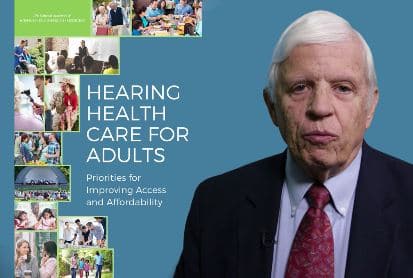WASHINGTON, DC — Today the National Academies of Sciences, Engineering & Medicine (formerly known as the Institute of Medicine) issued a potentially groundbreaking report on improving access and affordability of hearing health care for adults. The committee has been working well over a year, compiling a range evidence and opinion to support their recommendations to improve the delivery of hearing care services to all adults with hearing loss.
Dan Blazer of Duke University, chair of the 17-member committee, provided a 15 minute overview of the report, which included 12 recommendations. Committee members in attendance and providing commentary on the report were Nicole Marrone of the University of Arizona, Frank Lin of Johns Hopkins School of Medicine, and Brenda Battat of the Hearing Loss Association of America and attorney Ellen Flannery.
Perhaps most germane to hearing care professionals, the committee recommended the creation of a new device category for over-the-counter wearable hearing devices, the removal of the FDA requirement that individuals sign a medical waiver prior to hearing aid purchase, and that hearing technologies adopt more of an open platform approach that allow other providers to program and troubleshoot proprietary hearing aid software.

Dan Blazer, MD
Dr. Blazer provided context to the committee’s recommendations by citing evidence from the literature indicating that approximately 13% of individuals aged 12 and older have some degree of hearing loss and between 67% to 86% of adults aged 50 and over with hearing loss don’t use hearing aids. Further, Dr. Blazer mentioned that hearing loss of adult onset is associated with several co-morbidities, such as dementia & depression. For these reasons, according to the committee, hearing loss is a significant public health concern, and efforts should be made to provide adults with easier access to more affordable options for hearing health care, especially for those in underserved and vulnerable populations.
The committee cited the high costs of hearing aids, lack of insurance coverage, the stigma associated with wearing hearing aids, and limited awareness of available options as barriers to accessing hearing health care.
Additionally, the committee encouraged key stakeholders to evaluate and implement innovative hearing health care models to provide a greater range of solutions that improve quality and promote unbundling of services.
Committee Offers 12 Recommendations
Given the vital nature of hearing to communication and overall quality of life, as stated in their report, the committee made the following 12 recommendations, which the FDA, other governmental bodies and professional organization can take into consideration:
- Improve population-based information on hearing loss and hearing health care
- Develop and promote measures to assess and improve quality of hearing health care services
- Remove FDA’s regulation for medical evaluation or waiver of that evaluation prior to hearing aid purchase
- Empower consumers and patients in their use of hearing health care
- Improve access to hearing health care for underserved and vulnerable populations
- Promote hearing health care in wellness and medical visits for those with concerns about their hearing
- Implement a new FDA device category for over-the-counter wearable hearing devices
- Improve the compatibility and interoperability of hearing technologies with communications systems and the transparency of hearing aid programming
- Improve affordability of hearing health care by actions across federal, state, and private sectors
- Evaluate and implement innovative models of hearing health care to improve access, quality, and affordability
- Improve publicly available information on hearing health
- Promote individual, employer, private sector, and community-based actions to support and manage hearing health and effective communication
The complete 379-page report can be accessed here.







Kudos to NAS and well done. Some of the most critical changes were oversimplified in this article.
1-Bringing greater transparency to the market and using ANSI standards. This is very similar to what I requested in my FDA testimony.
2-Requiring interoperability which is part of my FCC and FTC complaints/Comments
3-Greater effective access.
This report is a landmark decision and a breath of fresh air for people with hearing loss.
What is the difference between item number one and number 11 on the list above?
#1 is more about research and data and #11 is about improving the quality of information that is available to the public.
Thank you for making hearing services more easy for people with hearing disorders ,but there is some point I want to comment on it
The over the counter hearing assisting devices this may adversely affect the status of hearing if it is used without scientific guidance
With my great thanks
As an Audiologist, I am disappointed that we are not even mentioned as the professional with the highest level of education trained to assist people with their hearing and hearing aid needs.
Still wondering why getting insurance to cover necessary hearing healthcare is nowhere on this list. Glaring omission in my opinion, because even when you lower the cost of hearing devices by unbundling the cost of the hearing aid from the cost of services, people still perceive them as expensive and then they skip their necessary aftercare because they have to pay for it. Most people do not have the vision, tools and dexterity to keep hearing aids adequately clean so they perform as intended. It’s NOT like glasses where you can simply wipe them off and they are fine. There are extremely tiny parts that get clogged with dirt, wax and moisture, compromising performance. What do these people think is going to happen when these OTC hearing aids get clogged up? Who’s going to maintain them? Are they going to end up in the drawer labeled as “junk” furthering the incorrect notion that hearing aids “don’t work” simply because they’re clogged in a place the consumer can’t see or get to? Professionals perform very necessary services to the hearing impaired population that go far beyond sticking a device in the ear, and regular cleaning and maintenance are only one aspect of it. It drives me nuts that everyone wants hearing aids to be just as simple as glasses, when they are not and never will be.